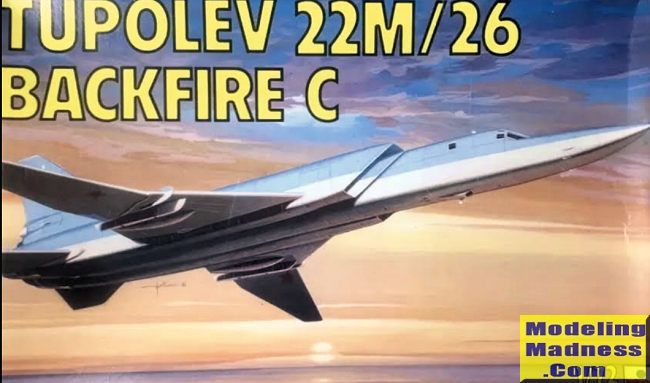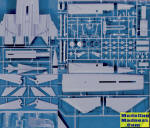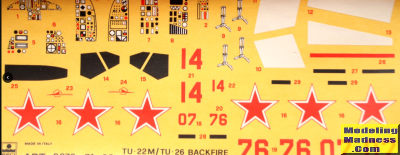ESCI 1/72 Tu-22M 'Backfire'
|
KIT #: |
9071 |
|
PRICE: |
$30.00 when new
|
|
DECALS: |
Three options |
|
REVIEWER: |
Spiros
Pendedekas |
|
NOTES: |
Re-released by Italeri in 2003 |

The Tu-22M "Backfire" (reported as being designated Tu-26 by western
intelligence at one time), is a supersonic, variable-sweep wing, long-range
strategic and maritime strike bomber developed by the Tupolev Design Bureau
in the 1960s. During the Cold War, it was operated by the Soviet Air Forces
(VVS) in a missile carrier strategic bombing role, and by the Soviet Naval
Aviation (Aviatsiya Voyenno-Morskogo Flota, AVMF) in a long-range maritime
anti-shipping role. As of 2021, there were 66 of the aircraft in service.
 Esci
came in 1989 with its 1/72 Tu-22M/Tu-26 “B” (the M2 version, featuring “F-4”
style intakes), followed by the “C” (the M3 version, with the “F-14” style
intakes) soon after. These kits were occasionally reboxed through the years
by AMT who had bought Esci, with the latest reboxing being the 2003 “M3”
version by Italeri.
Esci
came in 1989 with its 1/72 Tu-22M/Tu-26 “B” (the M2 version, featuring “F-4”
style intakes), followed by the “C” (the M3 version, with the “F-14” style
intakes) soon after. These kits were occasionally reboxed through the years
by AMT who had bought Esci, with the latest reboxing being the 2003 “M3”
version by Italeri.
These were not bad kits, especially for the times, featuring good molding,
adequate detail and, despite the model’s size, offered a quite pleasant,
uncomplicated build. The lack of accuracy in areas was not an uncommon trait
for USSR models of that era, since access to aircraft details was minimal,
with the kit designers working with whatever scarce reference thay had
available and, nevertheless, this kit is not a totally inaccurate rendition,
looking the part for sure.
The specific kit is the late 90’s “C” version, bought from a (sadly now
closed) Athens hobby shop at the reasonable price of $30 back then. The kit
comes in a big, relatively flimsy top opening box, with its box art
depicting an example banking lightly to the left.
Upon opening the box, I was greeted with around 100 light gray
styrene parts arranged in four sprues, with the lower fuselage part provided
separately. Of them the three sprues are common with both kit versions,
whereas the fourth smaller one caters for the intakes and nose of the
specific one. Molding is quite crisp with no flash noted. Panel lines are
recessed and tad on the deep side. General shapes of parts and external
details, including panel lines patterns, while definitely not confused with
anything else but a Tu-22M, are in areas not totally accurate and this
mainly has to do with the aforementioned restricted info the kit designers
had on hand at those times.
Cockpit is quite simplistic, featuring only seats, yokes and instrument
panels (their faces are represented by good looking decals and also decals
are used for the seat belts), with all above elements being generic
representations of the originals. Luckily, once the canopy is attached,
whatever will be visible would look nicely busy. Landing gear is adequately
rendered, with the bays and doors featuring some generic molded-on detail,
which is better than total blandness.
The fuselage is split in front and rear sections, the latter
containing the wing mechanism. The wings are designed to be movable via a
simple mechanism, however its sturdiness and ability to keep the wings
horizontal, especially over time, has to be determined and you may consider
gluing the wings permanently at a fixed position. One of the type's key
areas, that of the air intakes, is totally void of detail and, unless you
somehow beef it up, painting it black will be a good decision, in order to
hide its emptiness. The exhausts, while not extremely detailed, are
passable.
As a note, a ventral entry hatch is provided, but I am not that sure one
existed in reality (the crew would enter form the top, via upward opening
hatches, which, by the way, are poorly represented), so you might wish to
permanently glue the entry hatch "closed" and fill/sand smooth.
Transparencies look well molded and quite clear. Instructions are the
typical 80's Esci ones, coming in the form of a b/w pamphlet, containing a
short history of the type, a color chart, with the construction spread in 18
simple and clear steps and color callouts provided throughout.
 Three
totally identical schemes are provided, featuring light gray topsides over
white undersides, only differing in the codes (namely for Red 07, 14 and 76
machines). Decals are well printed and look still usable after all these
years (of course, you can never know till you use them - Esci decals usually
did not age well). Colors are given in Humbrol, FS codes and in generic
form.
Three
totally identical schemes are provided, featuring light gray topsides over
white undersides, only differing in the codes (namely for Red 07, 14 and 76
machines). Decals are well printed and look still usable after all these
years (of course, you can never know till you use them - Esci decals usually
did not age well). Colors are given in Humbrol, FS codes and in generic
form.
Instructions want you to first assemble the cockpit and, together with the
nose bay, trap them between the front fuselage halves, with the two rear
crew windows already attached from the innards. The wings are next assembled
and trapped between the upper and lower rear fuselage halves, with the front
and rear fuselage sections then joined.
The tail planes, fin, exhausts, intakes and nose follow (35 grams of weight
are to be trapped in, to avoid tail sitting - I would add tad more for
safety, as the nose gear seems strong). Landing gear and ordnance is next
(some attention will be required to make all 14 wheels touch the ground),
ending a build that seems much simpler than, possibly, initially envisaged
(though “simple” might not always mean “easy”).
Definitely superseded by the latest and greatest (but also way more
expensive) Trumpeter offering (which has got the overall shape correct and
offers a plethora of details and options), this is merely a decent kit of
the iconic bomber. While the general shape does indeed indicate a Tu-22M, it
looks simplistic, not that detailed and not accurate compared to the
Trumpeter, but one must consider that Esci did the best they could back in
1989 where little information was available.
The kit can be built to depict a fair representation of the supersonic
bomber and the build itself does not seem that complicated. It can still be
found at quite cheap prices and, due to the simplicity of construction, can
possibly be a good candidate for your first modern bomber attempt.
Happy Modeling!
Spiros
Pendedekas
December 2023
Copyright ModelingMadness.com. All rights reserved. No
reproduction in part or in whole without express permission.
If you would like your product reviewed fairly and fairly quickly, please contact the editor or see other details in the
Note to
Contributors.
Back to the Main Page
Back to the Review
Index Page
Back to the Previews Index Page


 Esci
came in 1989 with its 1/72 Tu-22M/Tu-26 “B” (the M2 version, featuring “F-4”
style intakes), followed by the “C” (the M3 version, with the “F-14” style
intakes) soon after. These kits were occasionally reboxed through the years
by AMT who had bought Esci, with the latest reboxing being the 2003 “M3”
version by Italeri.
Esci
came in 1989 with its 1/72 Tu-22M/Tu-26 “B” (the M2 version, featuring “F-4”
style intakes), followed by the “C” (the M3 version, with the “F-14” style
intakes) soon after. These kits were occasionally reboxed through the years
by AMT who had bought Esci, with the latest reboxing being the 2003 “M3”
version by Italeri. Three
totally identical schemes are provided, featuring light gray topsides over
white undersides, only differing in the codes (namely for Red 07, 14 and 76
machines). Decals are well printed and look still usable after all these
years (of course, you can never know till you use them - Esci decals usually
did not age well). Colors are given in Humbrol, FS codes and in generic
form.
Three
totally identical schemes are provided, featuring light gray topsides over
white undersides, only differing in the codes (namely for Red 07, 14 and 76
machines). Decals are well printed and look still usable after all these
years (of course, you can never know till you use them - Esci decals usually
did not age well). Colors are given in Humbrol, FS codes and in generic
form.